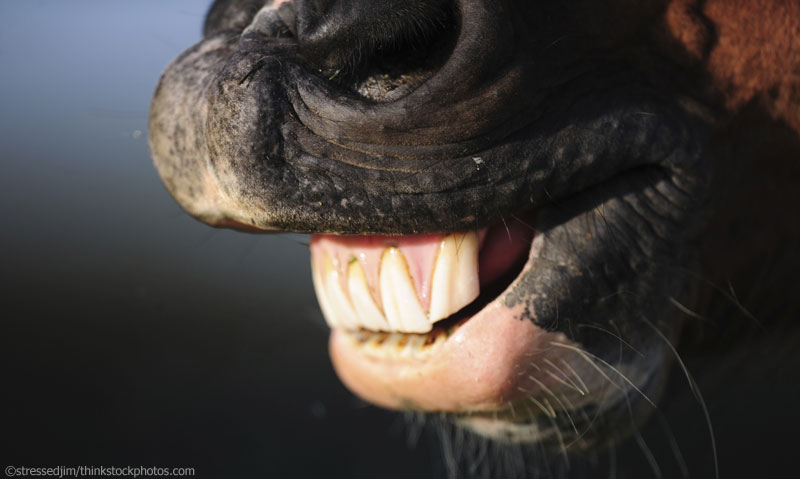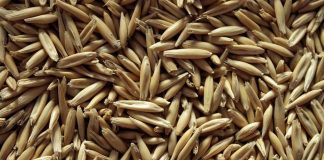By Rachel Parker

But truth be told, if you really did peel back the lips of your gift horse, would you really know how old he was anyway? Probably not. Fortunately, learning to determine equine age is not that much more complicated than counting the rings on a tree trunk — you just have to know what to look for. Continue reading and you’ll soon be lining up the horses at your barn in chronological order.
Tooth Wear
As a horse ages, his teeth wear down in a specific pattern. This results in characteristics that are common to all equine teeth as they approach certain ages. Both the temporary and permanent teeth follow the same sequence of wear: from the lower jaw to the upper jaw, and from front to back — or from the central incisor to the intermediate incisor to the back comer incisor.
The first sign of wear is the loss of the dark cup, a hollow space formed by the central enamel, which becomes filled with food. As the tooth wears, the pulp becomes exposed. This is referred to as a dental star. Also, when a tooth is young, its top, or table, is oval-shaped. As it wears down it becomes rounder, then triangular.
Galvayne’s Groove
Another way to assess age is by looking for Galvayne’s Groove. Found on the corner incisor, this line appears to travel from the top of the tooth to the bottom as the horse ages. It first appears in 10-year-olds. By 15 years of age, Galvayne’s Groove is halfway down the corner incisor. At 20, it reaches the full length of the tooth. After that it begins to recede from the gum line. It is halfway gone at the age of 25 and completely gone by 30.
The Shape of Teeth
As the tooth wears down, it changes from a long oval shape to a round shape and finally to a triangular one. When the horse reaches his 16th year, the central incisors become triangular. As with the wear of the dark cups, the pattern continues to the intermediate incisor in the horse’s 17th year. At 18, the back corner incisor becomes triangular, too.
Dental Fraud
Unfortunately, not everyone involved with horses uses this knowledge for good. Unscrupulous horse dealers may try to alter their horses’ teeth so they can pass them off as younger or older animals. They may pull the temporary teeth of a younger horse so that the permanent teeth will come in faster, making the horse appear to be older. Also, the teeth may be bishoped, or drilled, so that black marks appear instead of the white dental stars that characterize older horses. This effect may also be achieved by staining or burning the tables of the teeth.
However, these alterations can be detected by checking to see if the central enamel that forms the cup is visible. If the teeth have been bishoped, this enamel will not be present. Also, the slanting of the horse’s teeth and the shape of the teeth are unalterable. A younger horse’s teeth form a vertical angle as they meet each other, but as he ages, the angle juts out more and more, approaching an outward 90 degrees. And as mentioned, younger teeth are more oval, becoming more triangular and narrow with age.
Armed with this knowledge, you can make an informed decision when buying a horse — or just sneak a peak at the price tag on that gift.







The article was good, however a visual of each discription would have been helpful for those of us who need to see it to understand. Thanks.
I am not sure if viewing a horses teeth is very accurate. I had my 11 year old thoroughbred looked at and the dentist said that she was in her twenties. My Icelandic has no top teeth left. The dentist says that he is in his late twenties, early thirties, closer to thirties. There has to be another more accurate way to figure a horses age.
I found this article very informative, and even though I have been around horses all of my life, never really had someone explain the Galvayne Groove as clearly as this did. Kudos!! And Thanks!!
Hi I have a 3 yr old mini that I am worried about. His front gums are swollen and they are a dark pink. I am wondering if he could be getting his adult teeth in and his baby teeth are falling out. If anyone has any information on this it would be greatly appreciated. Thank you! Mindi
Well written. This was an interesting, yet very informative article.It kept your attention and gave the reader something to sink their teeth into at the same time.
Thank You so much for this article!I will be taking an ASIYP (American Saddlebred international Youth program) test and i knew almost all 130 and the most hardest was Galvayne’S groove. so thanks,now I know what it is!:)
Great article! I can’t believe someone would hurt or change a horse just to make some money!